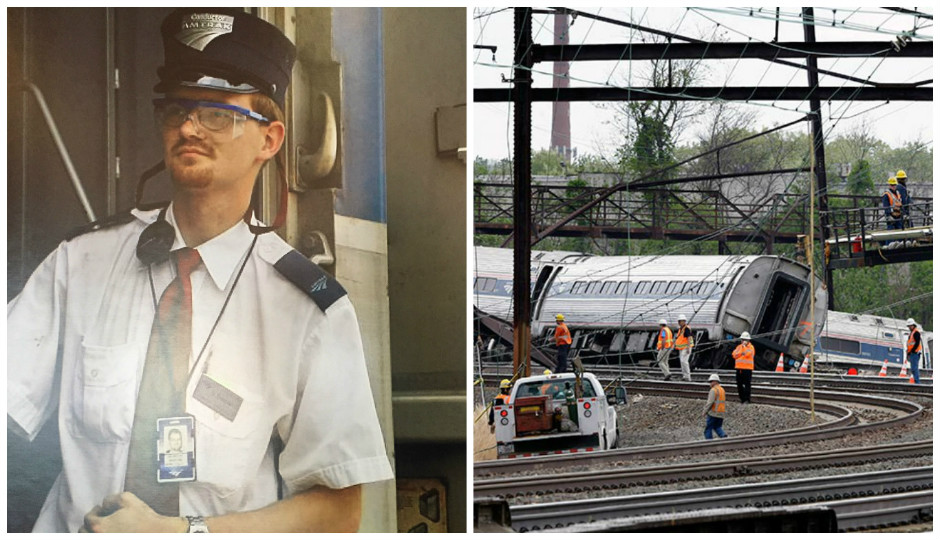Lawyers for Amtrak Victims Don’t Buy NTSB’s Report

L: Brandon Bostian (Courtesy of Robert Mongeluzzi) R: The aftermath of the Amtrak Train 188 derailment (AP/Mel Evans)
There had to have been some kind of explanation lurking under the twisted wreckage of Amtrak Train 188, something that went beyond simple human error.
That was one line of thought that hung around in the aftermath of the catastrophic crash in Frankford last May that left eight passengers dead and nearly 200 injured. Maybe the train had been peppered with gunfire, or pelted with rocks, like a nearby SEPTA train had that fateful night, or suffered some sort of crippling mechanical malfunction.
But in the end, the simplest explanation turned out to be the only one, according to the National Transportation Safety Board, which announced today that the crash was likely caused by the train’s engineer, Brandon Bostian, who was distracted by radio chatter about a SEPTA engineer who was injured in North Philly and then lost his bearings, mistakenly accelerating the train to 106mph as it approached a dangerous curve.
“This is a standard human error,” Steve Jenner, an NTSB investigator, told the board during a two-hour hearing. Investigators ruled out a host of other possibilities. Bostian hadn’t been on his cell phone, and wasn’t sick, intoxicated or fatigued, Jenner said. Nothing was wrong mechanically with the train, which hadn’t been struck by a bullet or any other type of projectile, despite early speculation along those lines.
But the NTSB didn’t fully pin the blame for the crash on Bostian. Christopher Hart, NTSB’s chairman, pointed out several times that the crash could have been averted if Amtrak had installed Positive Train Control along that stretch of the Northeast Corridor. The NSTB has been urging rail companies across the country to install PTC since the 1970s.
“This train would not have derailed” if PTC had been in place, Hart said at the opening of the hearing. The board listed the lack of PTC as a contributing factor in the derailment. It also explored the role that other elements played in the injuries passengers suffered, from the lack of seat restraints to the train’s windows. Dana Sanzo, another NTSB investigator, said four passengers were killed when they were ejected through emergency windows on the train, something that happened in a prior Amtrak crash in New York three years ago.
The NTSB also said Bostian suffered a head injury in the crash, and couldn’t remember what specifically happened in the moments leading up to the crash. None of this sat well with attorneys Robert Mongeluzzi and Tom Kline, who represent 32 passengers who were injured when the train derailed.
They took particular exception to the discussion about Bostian’s memory loss, going as far as displaying a chart of what they said are numerous examples of the engineer changing his story. Mongeluzzi said Bostian’s “selective memories” and evolving account of the crash “raises red flags” and need to be examined under the harsher glare of a deposition, as opposed to the engineer’s conversations with NTSB investigators.
Kline said there’s no doubt in his mind that Bostian’s conduct was reckless. “The conclusion that he may have lost his way is truly speculation,” he said.
Jenner said Bostian closely monitored six minutes worth of radio transmissions between a SEPTA engineer and SEPTA dispatchers after the engineer’s train was hit with a rock. The engineer was injured by shattered glass that hit his face. An NTSB board member asked why Bostian was so concerned about the SEPTA engineer. “He had a coworker back on the West Coast in California who was involved in an accident, and got glass in his face and suffered an eye injury,” Jenner said. “That was something he thought about.”
Bostian ultimately caught up with and passed the damaged SEPTA train as he directed the Amtrak train from 30th Street Station up towards Frankford, and was concerned that SEPTA might have had workers out on the tracks, the NTSB said.
Investigators believe that Bostian became disoriented — in part because of the darkness and lack of identifying signs in the area — and increased the train’s speed to 106 mph, perhaps thinking he was at a different portion of the tracks where that speed was safe, and not nearing a curve with a 50 mph speed limit. Kline, however, argued that Bostian was simply unnerved after hearing what happened to the SEPTA engineer and “wanted to get out of dodge.”
Jenner said Bostian had no record of prior problems with Amtrak, and crew members thought highly of him. Mongeluzzi said Amtrak hasn’t disciplined Bostian over the fatal crash.
The NTSB hearing touched on other aspects of the crash, from the way Philly cops scooped up injured passengers and rushed them to local hospitals to the uneven distribution of patients to the area’s trauma centers. The board also called on Amtrak to better train its engineers.
The hearing ended where it began, with Hart urging Amtrak and other rail operators to implement PTC before a looming federal deadline two years from now. “The real deadline is not 2018, but the next accident,” Hart said. “We do not know when that might occur. It’s time to make everyday count.”
Follow @dgambacorta on Twitter.


